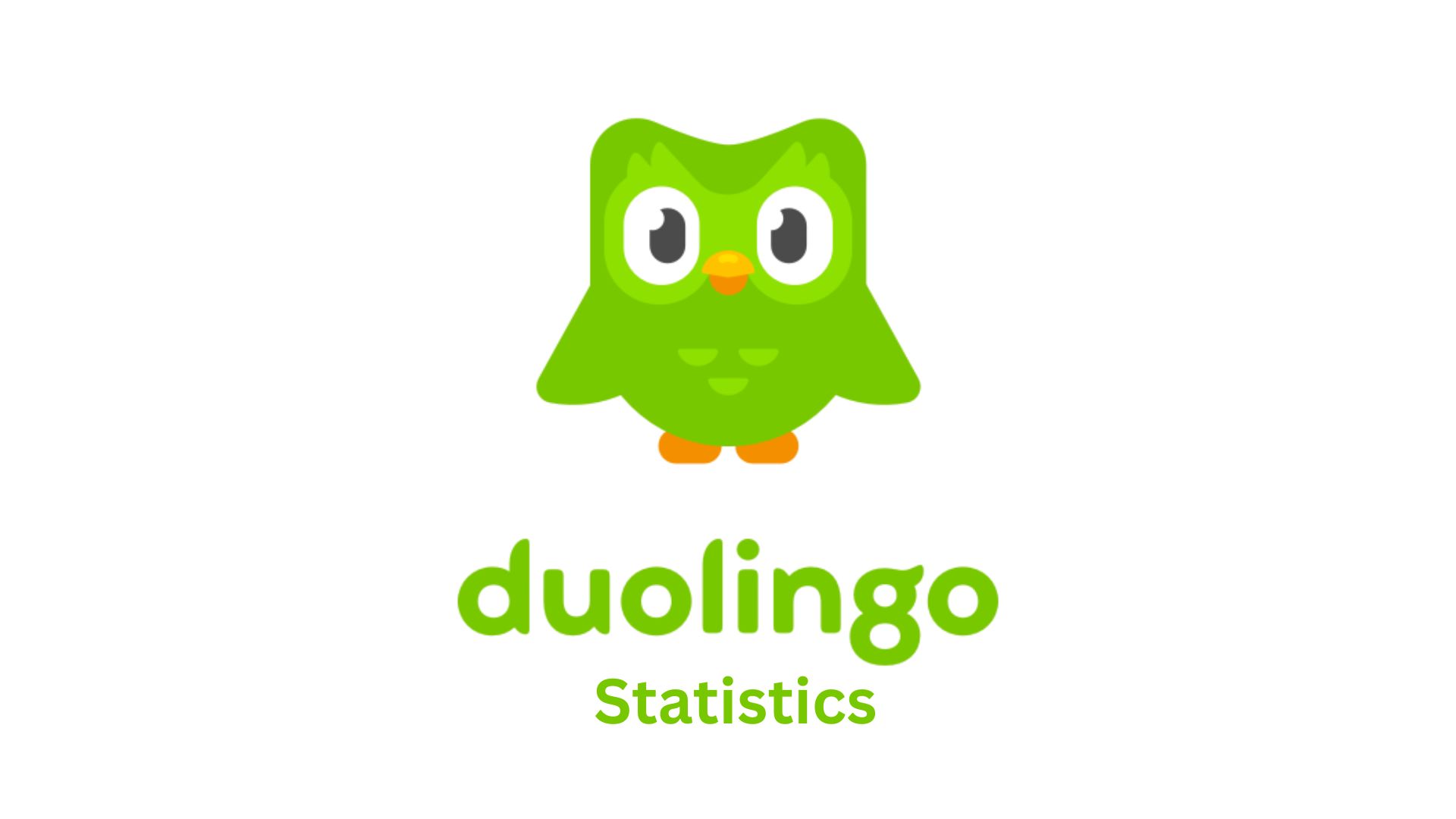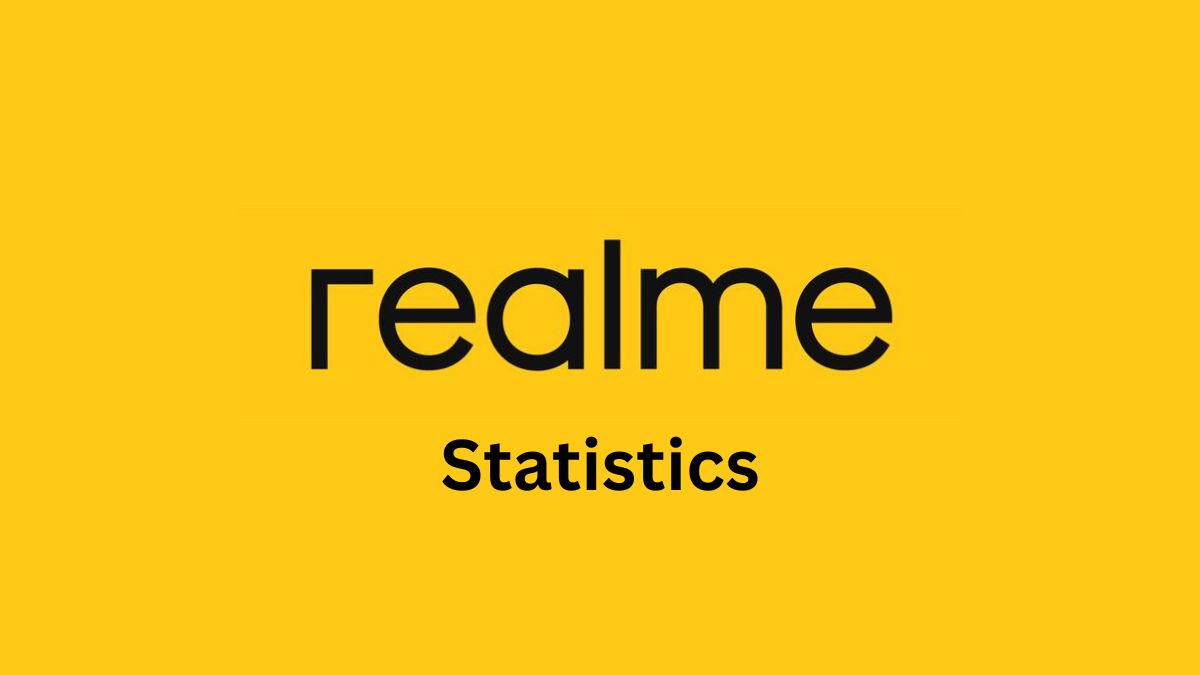Shopify Statistics and Facts (2025)
Updated · Sep 15, 2025

Table of Contents
- Introduction
- Editor’s choice
- Shopify Revenue
- Shopify Active Stores By Category
- Shopify Global Economic Sales
- Shopify Stores By Country
- Shopify Stores Traffic Distribution By Device
- Shopify App Statistics
- Shopify Market Share
- Shopify Merchant Statistics
- Shopify Users
- Shopify Share Price
- Shopify Competitors
- Conclusion
Introduction
Shopify Statistics: Shopify has been known as one of the best platforms that enable all kinds of businesses to build and empower their online presence. As of 2024, Shopify will be covering more than 175 countries with more than 5.46 million active stores and thus proving significant activity in monetary terms worldwide.
This article discusses the latest Shopify statistics and trends, its market share, revenue generation growth, users, and Active stores.
Editor’s choice
- As of 2024, Shopify operates across 175 countries, with over 5.46 million active stores.
- Shopify revenue has ramped from 205 million in 2015 to reach a staggering US $7.06 billion by 2023. It already reached US $6.023 billion in Q3 of 2024.
- Most popular Shopify store category in 2024: Apparel, with more than 288,000 stores. Home and garden (107,000+) came second, followed by beauty and fitness (102,000+).
- Globally, e-commerce sales amounted to US $6.09 trillion in 2024, rising to more than US $8 trillion in 2028.
- From the U.S., where Shopify counts 2,856,231 stores, followed by the U.K. (194,553), and Australia (142,382).
- Ever since traffic has been from computers, it has been shown by the following mobile phones: 40.3%, then 10% tablets.
- According to Shopify statistics, Product Reviews is the most installed app in Shopify (531,165 installations), followed by Geolocation (522,859).
- Shopify powers 27 percent of all e-commerce websites, leading the market by a distance followed by Wix Stores (20%) and WooCommerce Checkout (17%).
- Shopify Plus is utilized by more than 45,000 businesses, of which over 3,200 are based in the United Kingdom.
- Shopify’s user base has grown in a decade and now includes 41,000 from 2012. It is projected that in 2025, this number will be around 5.5 million.
- Shopify statistics reveal that the top stock price for Shopify back in November 2021 was US $1,762 per share, and it is estimated to trade right now for about US $106.78 per share.
- WooCommerce is Shopify’s primary and main rival, as it powers 6.15 million websites and reserves 38.74% of the e-commerce market.
- Other competitive alternatives to Shopify are BigCommerce (41,906 sites), Squarespace (5.49 million sites, 14.67% in market share), and Wix (8.55 million sites with over 700,000 online stores).
Shopify Revenue
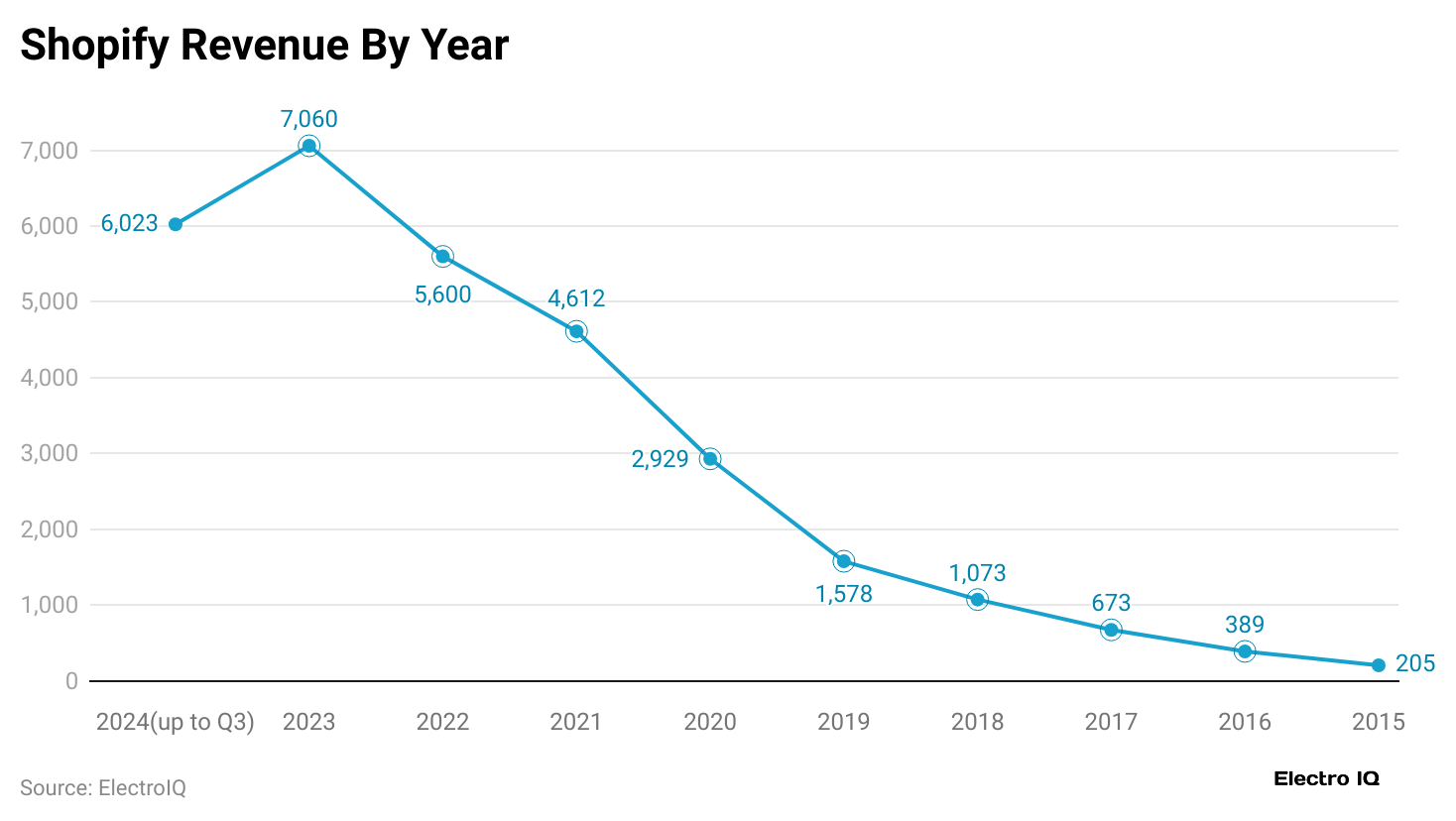
- Shopify statistics state that Shopify has certainly grown and earned significantly over the years, which indicates its pertinent presence in the e-commerce domain. In 2015, the company earned about US$205 million, and by 2016, almost double was earned at US$389 million.
- The upward move continued in 2017, when revenue of US$673 million was earned, which further went up to US$1,073 million in 2018.
- By 2019, Shopify had already entered the US$1.5 billion suite with US$1,578 million earned. The momentum picked up in 2020, the year for the boom in online shopping, with revenue at US$2,929 million. This high growth momentum continued in 2021, with earnings reaching US$4,612 million, and in 2022, Shopify earned US$5,600 million in revenue.
- The highest revenue year for the company has, until now, been 2023, with US$7,060 million in revenue, demonstrating a big leap from previous years.
- In 2024, until the end of the third quarter, Shopify had already booked US$6,023 million in revenue, showing strong potential to break its previous record by the end of the year.
- The consistent growth of the company establishes Shopify’s increasing market growth and its ability to catch up with the boom in global e-commerce.
Shopify Active Stores By Category
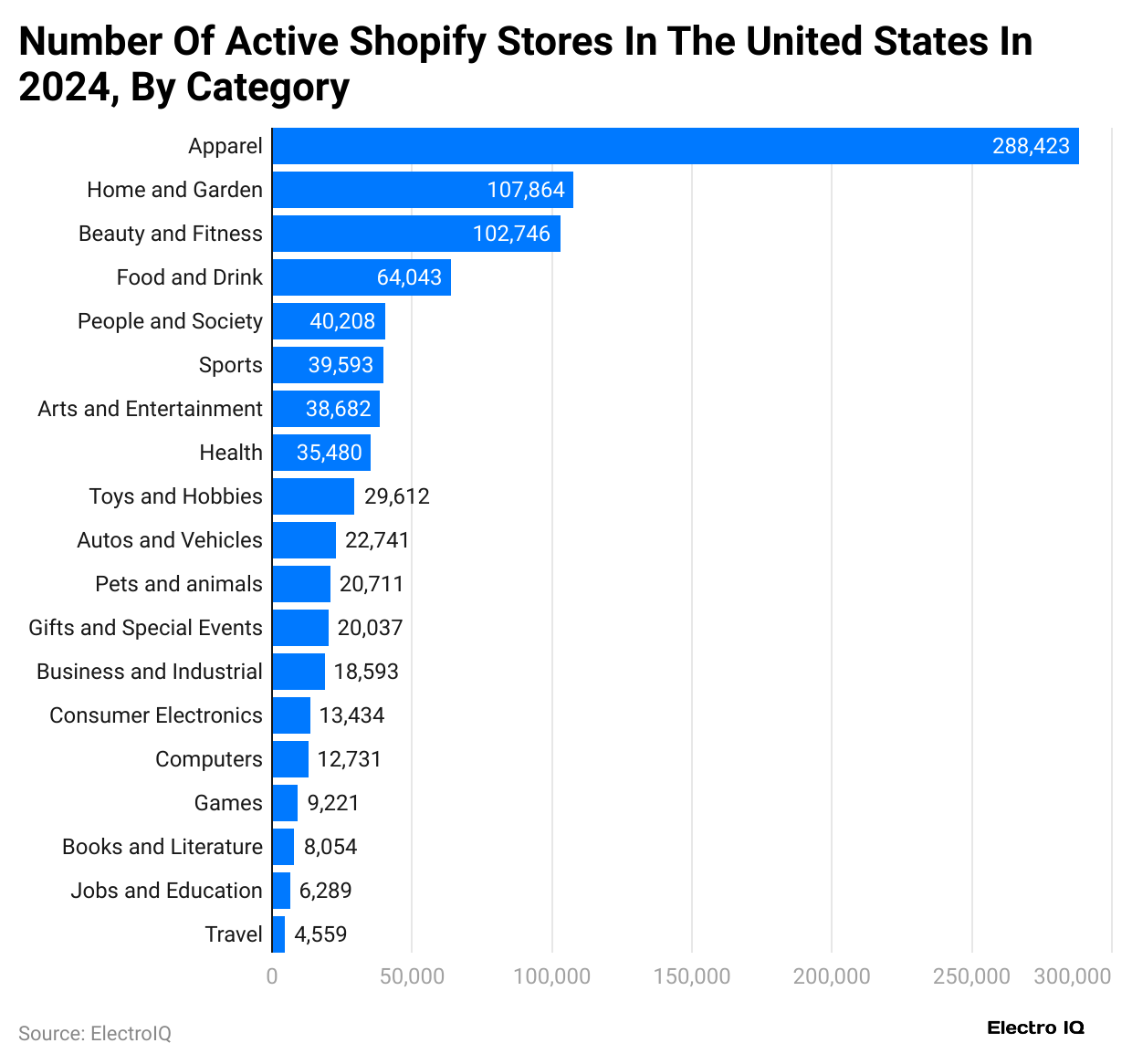
- Shopify statistics show that as of 2024, apparel had emerged as the most favored type of Store on Shopify, totaling more than 288,000 Stores offering clothing and fashion-related products.
- Next would be home and garden, with over 107,000 Stores selling furniture, décor, and household items.
- Beauty and fitness were not far behind, with about 102,000 Stores selling items used for skin and cosmetics and health-related purposes.
- This means that fashion, home essentials, and personal care remain the top breadwinners for e-commerce on Shopify.
Shopify Global Economic Sales
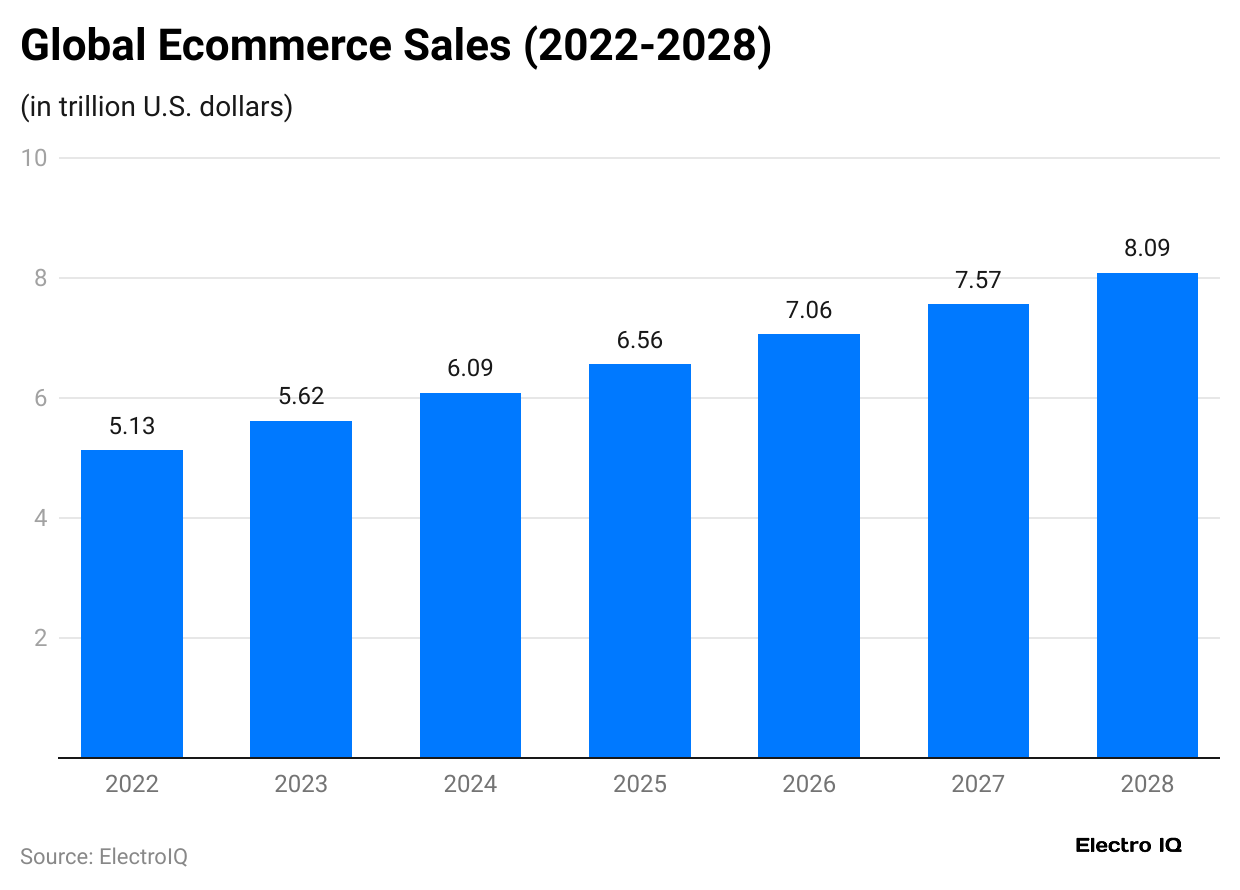
- Global e-commerce sales have consistently shown growth over the years, signifying that online shopping is here to stay. In 2022, global e-commerce sales stood at US$5.13 trillion, marking a 6.0% annual increase.
- The following year, while sales inflated to US$5.62 trillion, the growth rate came at higher levels of 9.7%. 2024 was marked by an ongoing rise in sales, which reached US$6.09 trillion, albeit with a tad-bit slower 8.4% rise.
- For the next coming years, steady expansion with a couple of rises is projected within the e-commerce circle. Global sales would touch US$6.56 trillion in 2025, which is a 7.8% rise.
- Sales one year later are projected to reach US$7.06 trillion, with a growth rate of 7.5%.
- E-commerce sales are then expected to reach US$7.57 trillion by 2027, indicating a 7.2% yearly rise. By 2028, sales will outperform US$8 trillion with 6.9% growth.
- The market is expanding, yet the annual growth rate is steadily declining. This is a matured market, with e-commerce at its heart, showing smooth growth in contrast to the boom of yesteryears.
- Shopify statistics underpinned the continuous growth of digital commerce, developments in technology, increased internet penetration, and shifting consumer behavior.
Shopify Stores By Country
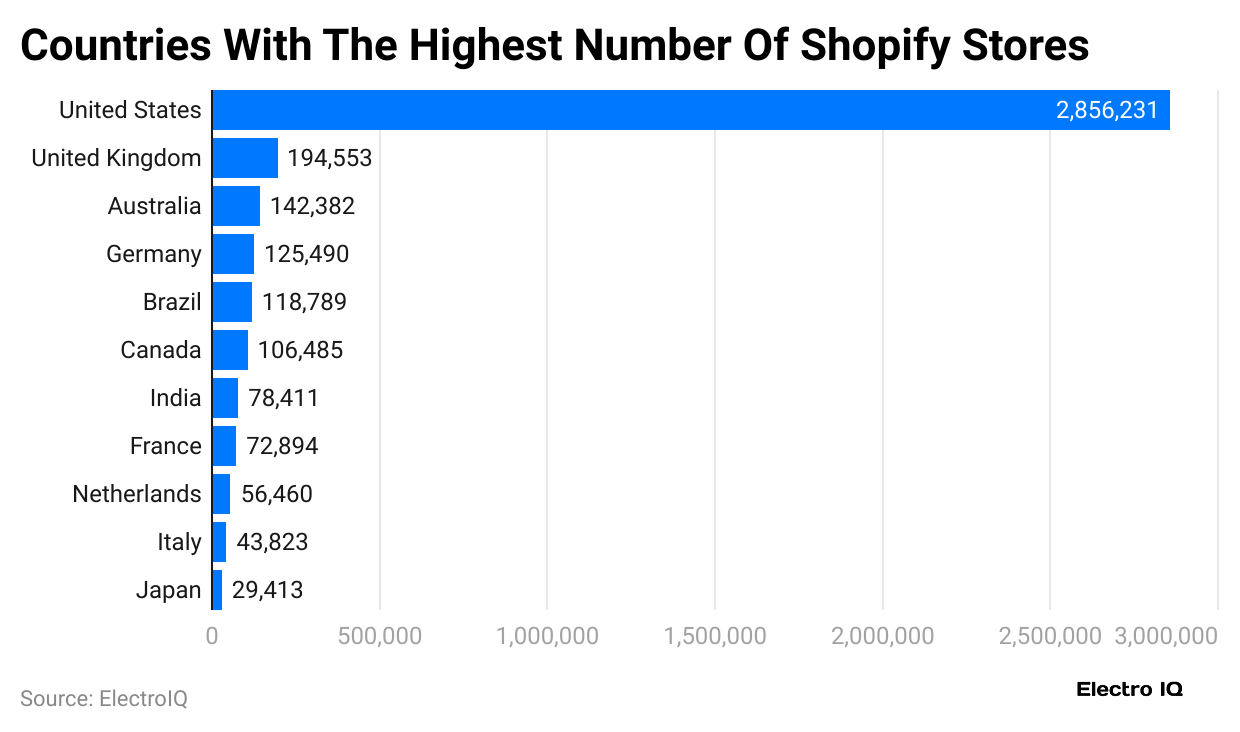
- Shopify has a huge global footprint, with the U.S. topping the list with the highest number of Shopify stores, numbering at 2,856,231.
- This means that this country accounts for the majority of Shopify users worldwide, reflecting how robust the e-commerce ecosystem is when it comes to business adoption in the United States. United Kingdom comes next with 194,553 stores, further demonstrating the platform’s popularity within the European market.
- With 142,382 Shopify stores, Australia takes the third position, indicating online retail solution growing preference in the country.
- Germany, with another major European market, has 125,490 Shopify stores, emphasising its role as one of the major hubs for e-commerce. In fifth place is Brazil, with 118,789 stores, thus confirming that Shopify has been penetrating and spreading more into Latin America.
- Canada, the home country of Shopify, has 106,485 stores, which shows good domestic penetration of the platform.
- And then comes India, with 78,411 Shopify stores, showing an increasingly active e-commerce segment in the nation.
- France also records online retail significance with 72,894 stores. The Netherlands, with 56,460 Shopify stores, further strengthens the expanding coverage of Shopify in Europe. Italy, with 43,823 stores, adds to this growing presence of the platform in this region.
- Last in this list is Japan, with 29,413 stores, which shows that Shopify is expanding its footprint within the Asian market.
- Such Shopify statistics illustrate the worldwide persisting expansion of Shopify and the extensive adoption of it among different regions.
Shopify Stores Traffic Distribution By Device
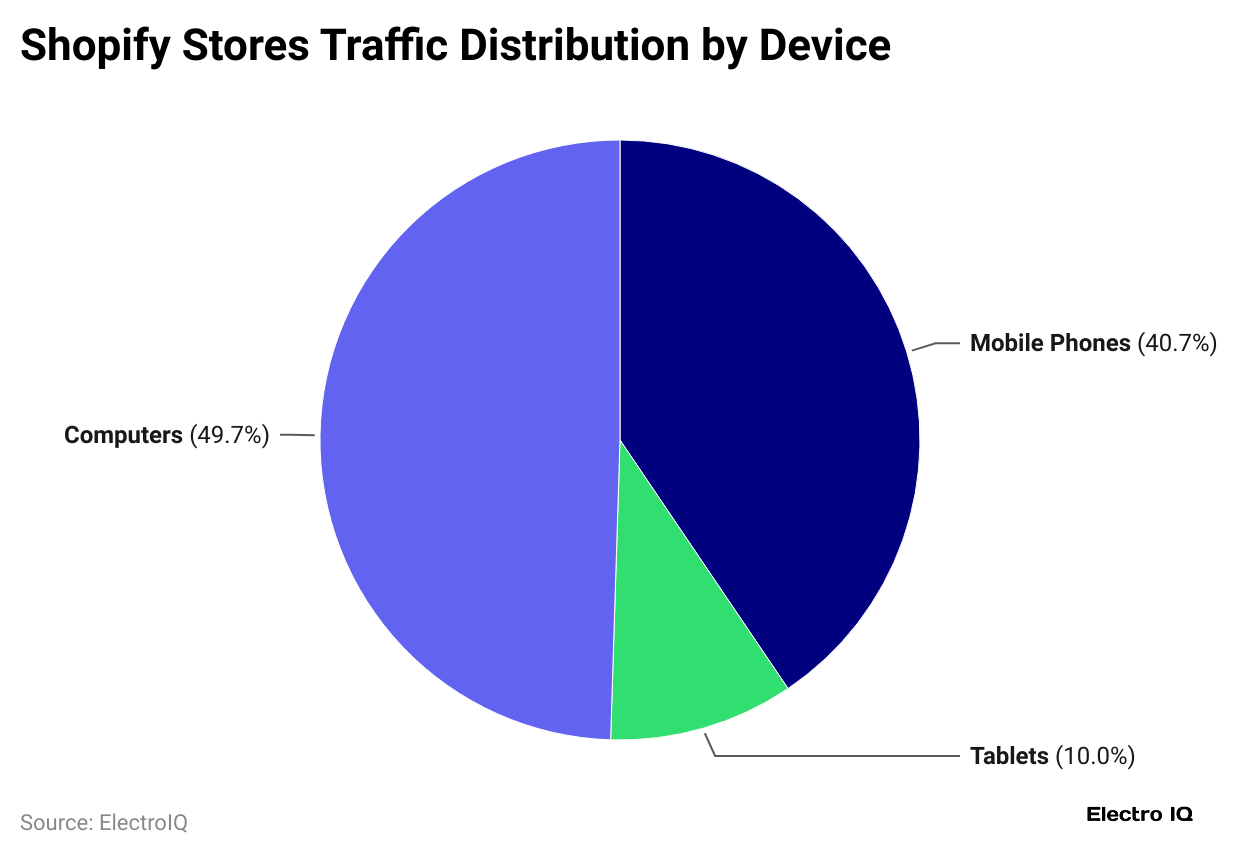
- Shopify provides a distribution of traffic across many different devices. Computers rank highest in usage for traffic at 49.7%.
- Shopify statistics indicate half of Shopify visitors prefer browsing and shopping through desktops or laptops, likely due to larger screens and easier navigation for more complicated purchases.
- Mobile phones see some 40.3% in traffic share, reflecting the trend in mobile commerce, hence suggesting most consumers do shop while on the move by using smartphones for immediate and convenient access to online stores.
- The remaining 10% of traffic comes from tablets, which provide a middle road for users who want portability but at the same time a larger screen area than a smartphone.
- This data shows the importance of creating an infrastructure to ensure e-commerce stores are running perfectly on different devices to create a delightful experience for users across desktops, tablets, and mobile phones.
Shopify App Statistics
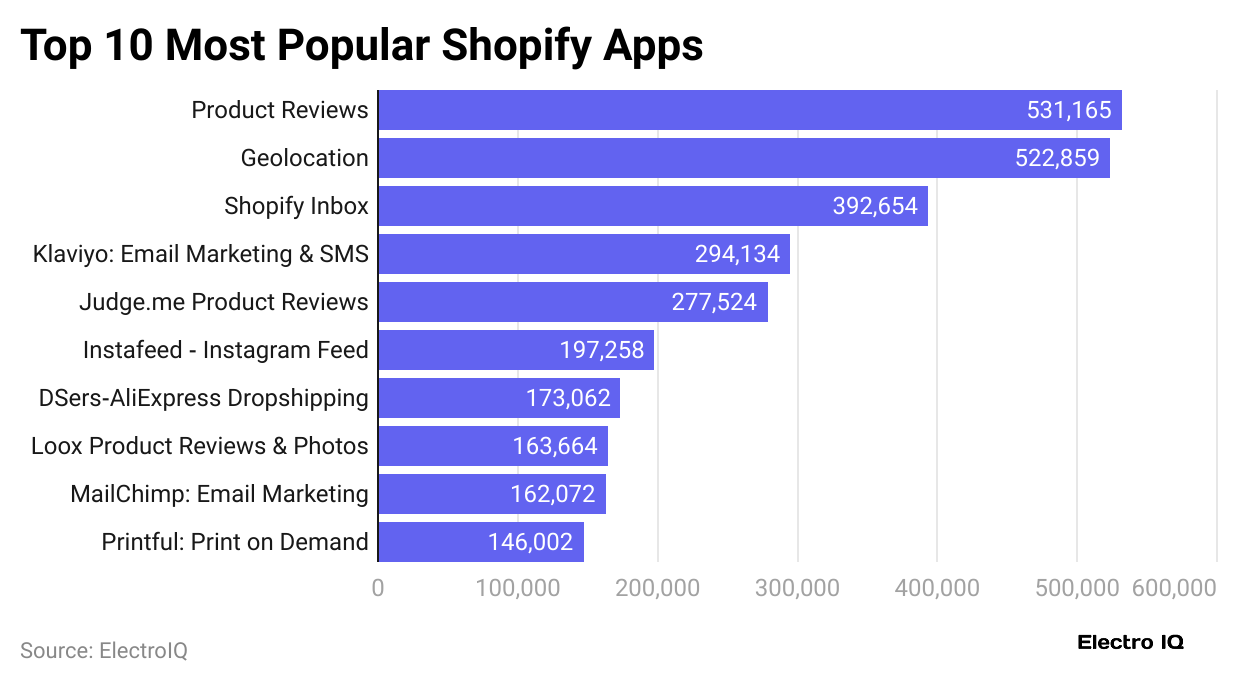
- The Shopify App Store has lots of applications that merchants can install to build more features into their stores.
- Shopify statistics reveal that the most famous app so far, Product Reviews, tops the list with 531,165 installations from merchants, which emphasises how appealing customer feedback is to visiting customers who are influenced in their buying decisions.
- Geolocation follows closely at 522,859 downloads, empowering companies to personalise content-wise, currency-wise, or even both-wise depending on a customer’s location.
- Shopify Inbox, which has been installed by about 392,654 people, has almost all merchants using it to talk to customers over different platforms.
- Klaviyo: Email Marketing & SMS stands tall at 294,134 installs, highlighting the growing adoption of targeted emailing and SMS message campaigns to create an inroad with customers.
- One other trusted platform for bringing in and viewing customer reviews further strengthened its trust with 277,524 installations: Judge.me Product Reviews. Instafeed-Instagram Feed has 197218 downloads following the social media integration type because it helps merchants show off their Instagram images in stores.
- Among the dropshipping applications, DSers-AliExpress Dropshipping performs best at 173,062 installations, boasting how well this tool has simplified product sourcing from AliExpress.
- Visual engagement, mostly for the reason of helping owners, is as favored by most store owners as Loox Product Reviews & Photos; such a popular app that has recorded installations of about 163,664, making it easier for businesses to showcase customer-generated photo reviews.
- MailChimp is, and remains so, the most common application for email marketing automation with 162,072 downloads.
- Finally, in terms of installations, Printful: Print on Demand takes the cake with a whopping 146,002 installations, indicating that many e-commerce entrepreneurs want their custom print-on-demand products.
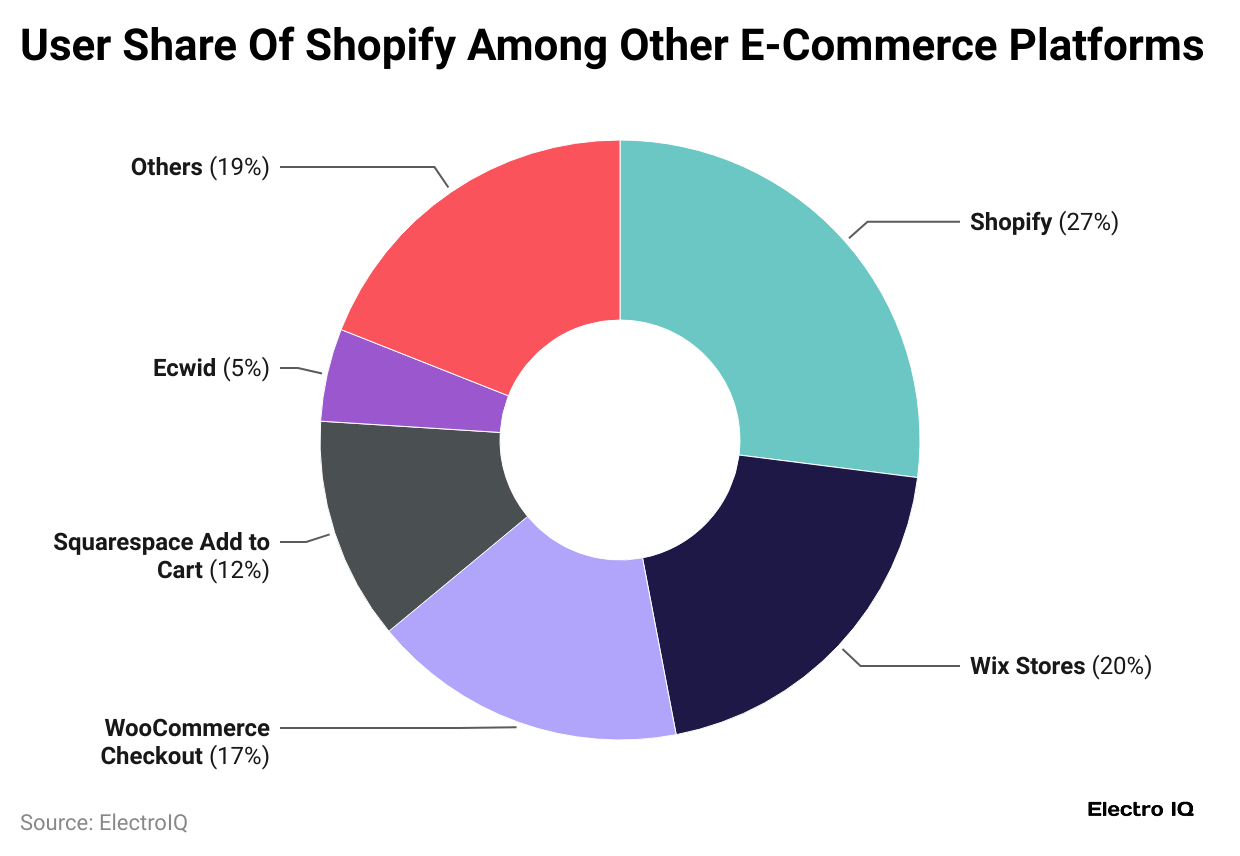
- Shopify statistics state that Shopify has continued to be a leading player in e-commerce. From its own influence, some 27% of all e-commerce sites currently operating worldwide run on its platform. It is thus the most widely adopted e-commerce platform, accommodating businesses of varying sizes in the exploitation of its ease of use, rich feature set, and scalability.
- After Shopify, Wix Stores makes for a strong protagonist in the market, maintaining a 20% share, especially among small companies and entrepreneurs that seek a highly intuitive website building process for e-commerce.
- WooCommerce Checkout, an e-commerce plugin for WordPress, constitutes 17% of the market, growing as a choice for mostly anybody interested in WordPress for the content management side of things while putting on e-commerce functionality.
- While serving creative professionals and small businesses interested in handsome online shops, Squarespace’s Add To Cart claims a market share of 12%.
- With 5%, Ecwid offers a lean yet flexible e-commerce solution that can be embedded into any website or set up to serve content through social media.
- The other 19% can be attributed to other e-commerce technologies like Magento, BigCommerce, and custom-built systems that cater to specific niche markets and particular business needs.
- Therefore, these statistics reveal the leadership position rightly held by Shopify in the e-commerce industry and the presence of competitive platforms that service assorted categories of merchants and models.
Shopify Merchant Statistics
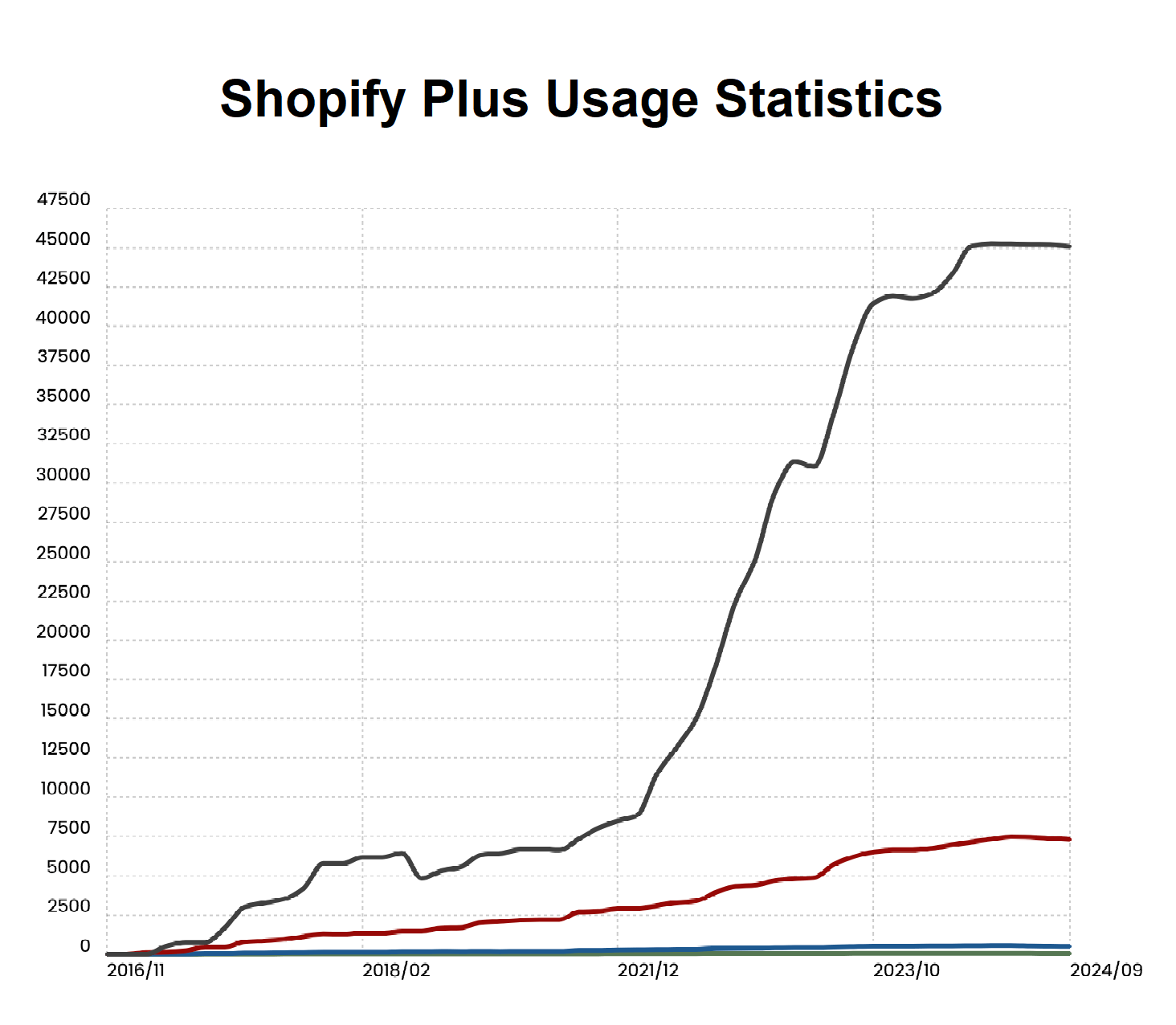
- As of 2024, the number of live Shopify Plus stores stands above 45,000, taking advantage of the Shopify infrastructural equilibrium and of these stores, nearly 3,200 are from the UK.
- Shopify Plus ensures higher GMV and higher gross profits, making it the first choice for scaling brands.
- Some prominent names among these scaling brands include Whole Foods Market.
- During the pandemic, Shopify gained a lot of market growth because of the huge increase in online shopping, hence facilitating the demand for enterprise solutions like Shopify Plus.
- Shopify Plus keeps on providing new features and technologies to suffice business growth throughout the best overall platform in scaling brands.
Shopify Users
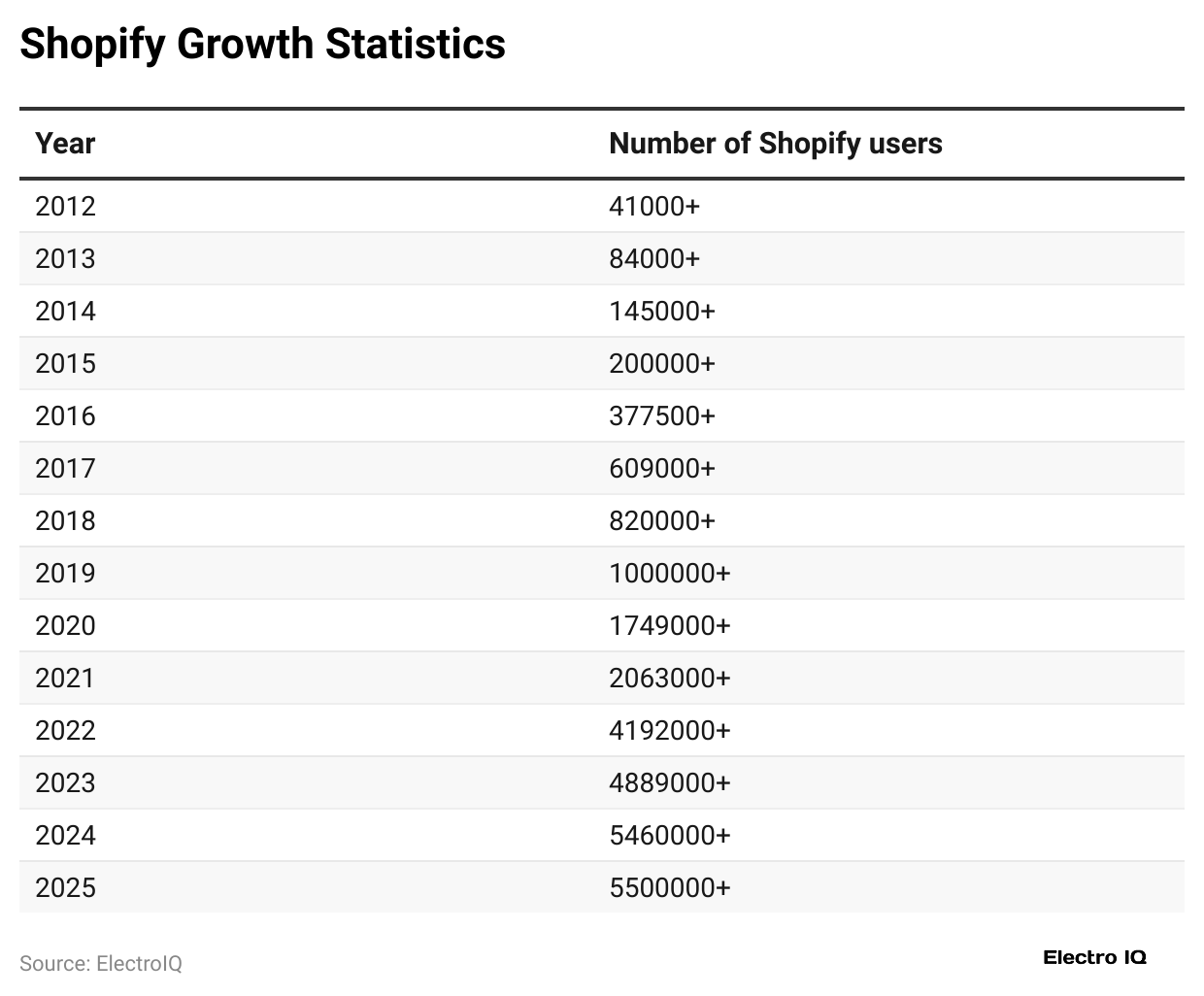
- Shopify statistics indicate the expansion of Shopify users over the years from 2012 to 2025, which also shows a consistent increase in the pattern of adoption by the years.
- In 2012, Shopify had just over 41,000 users, and this number had more than doubled to 84,000+ by 2013. In 2014, the increase continued with 145,000+ users and then reached 200,000+ by 2015. The growth rate accelerated in further years with the user base increasing to 377,500+ in 2016, then to a major jump in 2017 with 609,000+.
- Again, by the following year (2018), the platform attracted an impressive 820,000+ users nearing the one million mark.
- Finally, the milestone was crossed in 2019, with the total number of users increasing to over one million, specifically 1,000,000+.
- The e-commerce boom that came with the pandemic led to the straight-line form of growth as already seen. Results for 2020 indicate over 1,749,000 users increased to 2,063,000 in 2021. Growth more than doubled in 2022 with over 4,192,000 users, showing the trend toward Shopify becoming dominant in e-commerce.
- In 2023, the platform had around 4,889,000 users, and the number grew to about 5,460,000 in 2024.
- Recent Shopify statistics reveal that this trend is expected to continue in 2025, with predictions that Shopify will exceed 5,500,000 users by that year.
- Thus, all this data indicates that Shopify is rapidly expanding and effectively enhances digital commerce’s presence in the market in many sectors nowadays, particularly as more businesses and entrepreneurs turn toward online retail.
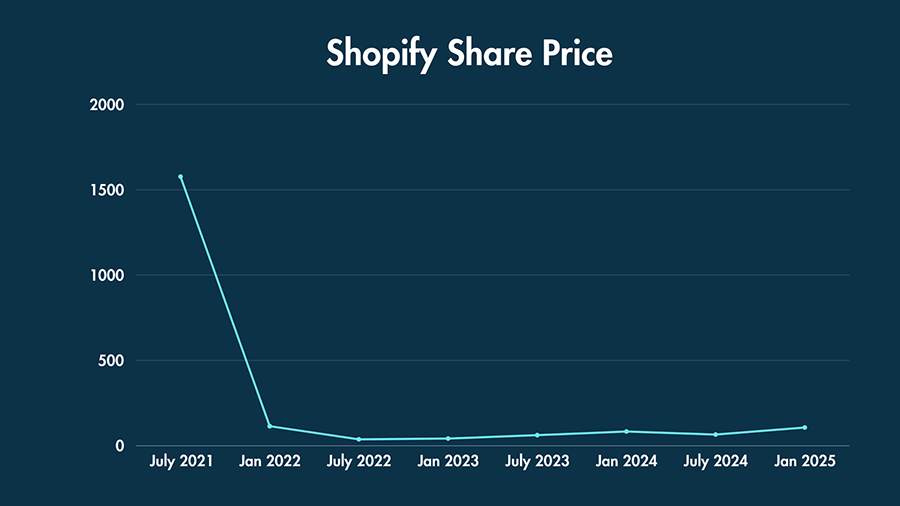
- According to Shopify statistics, Shopify’s share price is now almost US$106.78. The initial public offering (IPO) of the company was held on May 20, 2015, and it was listed as “SHOP” on the New York and Toronto stock exchanges on the following day. The IPO finally closed on May 27, 2015.
- Presently, Shopify has a market capitalisation of US$84.15 billion. In July 2021, Shopify’s shares were trading at US$1,577 with the highest peak at around US$1,762 as of November 2021.
- Although Shopify has a strong market presence, the company does not offer nor pay any dividend in cash.
- The company has mentioned that it has never provided dividends and there seems to be no intention at this point in the future, as it would rather reinvest any future earnings to keep its business operations running.
Shopify Competitors
- WooCommerce is one of Shopify’s main competitors and holds a comparable market share. Currently, 6,149,588 websites use WooCommerce for online sales, and it powers 14% of the top one million websites. In the overall e-commerce platform market, WooCommerce accounts for 38.74% of all e-commerce websites. It also dominates the e-commerce plugin market, holding an impressive 93% share, far surpassing Ecwid, its closest competitor, which has only 5%. Shopify’s ‘Buy Button,’ by comparison, is utilised by approximately 20,794 websites.
- BigCommerce is another strong alternative to Shopify, offering a similar range of features, pricing, and usability for businesses of all sizes. Currently, it hosts 41,906 live e-commerce websites and has a market share of about 0.17% among the top one million hosted websites.
- Squarespace is also emerging as a direct competitor to Shopify. Originally designed as a website builder for portfolios and brochure sites, it has steadily expanded its e-commerce capabilities. Across the entire e-commerce market, Squarespace holds a 14.67% market share, with 5,494,572 live websites using the platform. However, when considering the top one million e-commerce sites, its market share drops to just 0.3%.
- Wix, another website builder that has ventured into the e-commerce space, is also gaining traction. Currently, 8,551,029 websites are powered by Wix, and the company reports that more than 700,000 of these are online stores.
Conclusion
Shopify is the backbone of the global e-commerce economy, empowering millions of merchants and providing a huge medium for economic activities. This is evident from its current market share, excellent revenue growth, and technological innovation, all elements putting its future in the direction of online retail. With the times changing, Shopify’s adaptability to trends and its merchant-centric approach guarantee that it will be at the forefront of success for years to come.
Sources
FAQ.
By 2024, Shopify powers more than 5.46 million active stores in 175 countries, out of which the United States has the highest count of 2,856,231 stores.
As of Q3 2024, Shopify has achieved US$6.023 billion in revenue and has shown strong growth from US$7.06 billion in 2023.
The top-selling Shopify store categories in 2024 are: Apparel (288,000+ stores), Home & Garden (107,000+ stores), Beauty & Fitness (102,000+ stores).
Shopify powers 27% of all e-commerce websites in the world, ranking as the number one e-commerce platform, followed by Wix Stores with 20% and WooCommerce Checkout with 17%.
WooCommerce is Shopify’s biggest rival with 6.15 million websites running on it and has an approximate e-commerce market share of 38.74%. Other competitors would be BigCommerce, Squarespace, and Wix.

Joseph D'Souza founded ElectroIQ in 2010 as a personal project to share his insights and experiences with tech gadgets. Over time, it has grown into a well-regarded tech blog, known for its in-depth technology trends, smartphone reviews and app-related statistics.





